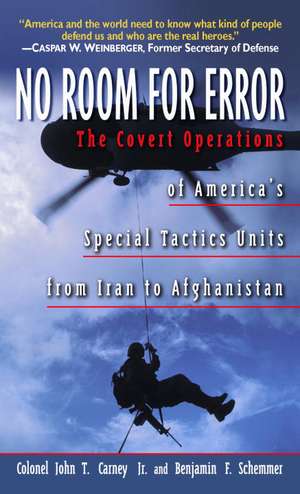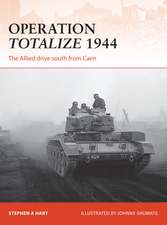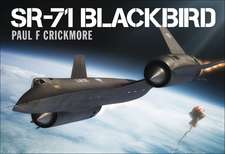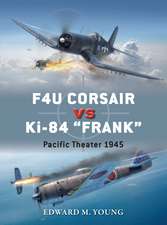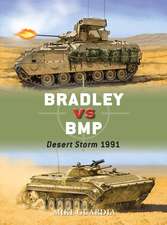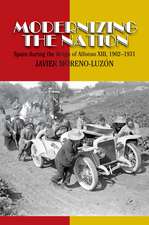No Room for Error: The Story Behind the USAF Special Tactics Unit
Autor T. Col Carney, Jr. Carney, John T., Benjamin Schemmeren Limba Engleză Paperback – 31 aug 2003
–LT. COL. L. H. “BUCKY” BURRUSS, USA (Ret.)
Founding member and Deputy Commander of Delta Force
When the U.S. Air Force decided to create an elite “special tactics” team in the late 1970s to work in conjunction with special-operations forces combating terrorists and hijackers and defusing explosive international emergencies, John T. Carney was the man they turned to. Since then Carney and the U.S. Air Force Special Tactical units have circled the world on sensitive clandestine missions. They have operated behind enemy lines gathering vital intelligence. They have combated terrorists and overthrown dangerous dictators. They have suffered many times the casualty rate of America’s conventional forces. But they have gotten the job done–most recently in stunning victories in the war on terrorism in Afghanistan, which Carney calls “America’s first special-operations war.” Now, for the first time, Colonel Carney lifts the veil of secrecy and reveals what really goes on inside the special-operations forces that are at the forefront of contemporary warfare.
Part memoir, part military history, No Room for Error reveals how Carney, after a decade of military service, was handpicked to organize a small, under-funded, classified ad hoc unit known as Brand X, which even his boss knew very little about. Here Carney recounts the challenging missions: the secret reconnaissance in the desert of north-central Iran during the hostage crisis; the simple rescue operation in Grenada that turned into a prolonged bloody struggle. With Operation Just Cause in Panama, the Special Tactical units scored a major success, as they took down the corrupt regime of General Noriega with lightning speed. Desert Storm was another triumph, with Carney’s team carrying out vital search-and-rescue missions as well as helping to hunt down mobile Scud missiles deep inside Iraq.
Now with the war on terrorism in Afghanistan, special operations have come into their own, and Carney includes a chapter detailing exactly how the Air Force Special Tactics d.c. units have spearheaded the successful campaign against the Taliban and Al Qaeda.
Gripping in its battle scenes, eye-opening in its revelations, No Room for Error is the first insider’s account of how special operations are changing the way modern wars are fought. Col. John T. Carney is an airman America can be proud of, and he has written an absolutely superb book.
From the Hardcover edition.
Preț: 58.56 lei
Nou
Puncte Express: 88
Preț estimativ în valută:
11.21€ • 11.50$ • 9.44£
11.21€ • 11.50$ • 9.44£
Carte disponibilă
Livrare economică 05-19 februarie
Preluare comenzi: 021 569.72.76
Specificații
ISBN-13: 9780345453358
ISBN-10: 0345453352
Pagini: 368
Dimensiuni: 107 x 174 x 25 mm
Greutate: 0.19 kg
Editura: Presidio Press
ISBN-10: 0345453352
Pagini: 368
Dimensiuni: 107 x 174 x 25 mm
Greutate: 0.19 kg
Editura: Presidio Press
Notă biografică
Col. John T. Carney Jr., the founding father of Air Force Special Tactics, was the first commanding officer of any such unit. Originally a six-man team known as Brand X, this elite unit now comprises a group of seven squadrons deployed worldwide. In 1996, Carney was presented the U.S. Special Operations Command Medal for his outstanding contributions to the revitalization of special operations, and, in 1997, he was inducted into the Air Commando Hall of Fame. He is now President of the non-profit Special Operations Warrior Foundation providing full college scholarships to over 360 children of Special Operators killed in service to their country. He lives in Tampa, Florida.
Benjamin F. Schemmer is a West Point and Army Ranger graduate, and a former paratrooper. He is the author of The Raid. He has written for The Washington Post and Los Angeles Times and has long been a frequent lecturer at military command, staff, and war colleges. He lives in Naples, Florida.
From the Hardcover edition.
Benjamin F. Schemmer is a West Point and Army Ranger graduate, and a former paratrooper. He is the author of The Raid. He has written for The Washington Post and Los Angeles Times and has long been a frequent lecturer at military command, staff, and war colleges. He lives in Naples, Florida.
From the Hardcover edition.
Extras
TUNGI, AFGHANISTAN
The first war of the twenty-first century quickly became America's first special operations war. President George W. Bush's "war on terrorism," triggered by the September 11, 2001, attacks on New York's World Trade Center and the Pentagon, began on October 7 when Bush and Defense Secretary Donald Rumsfeld announced the first U.S. air strikes against forces of the repressive Taliban regime and al-Qaeda terrorists in northern Afghanistan as part of Operation "Enduring Freedom." Within a few weeks they would announce the first two raids by American Rangers and other special operations forces in Afghanistan and acknowledge that small, clandestine teams of American special forces and special tactics units had begun operating directly with Afghan anti-Taliban tribesmen.
Air Force special tactics, Army special forces teams, and Army Rangers, Rumsfeld said, were targeting Taliban forces for long-range U.S. air strikes supporting Northern Alliance troops, gathering on-the-spot intelligence, and conducting unconventional hit-and-run raids on key targets. Soon after the Army-Air Force teams had infiltrated Afghanistan, Navy SEAL units also began operating there.
A brave young Afghan described the role that these special operators played in that war during a fierce firefight in eastern
Afghanistan in January 2002, when an American special forces and special tactics team leading anti-Taliban forces came under such withering fire that his comrades fled the battleground. Taliban and al-Qaeda fighters had depressed their antiaircraft guns on the hills and mountains surrounding the U.S.-led troops and were inflicting gruesome losses. But this particular Afghan stayed as the Americans held their ground and Sergeant William "Calvin" Markham, a special tactics combat controller, radioed for close air support strikes to suppress and destroy the enemy weapons. In the midst of this raging and bloody battle, the Afghan flung himself to the ground directly in front of the American sergeant to protect him from incoming rounds. Markham yelled at him, "What are you doing?" The Afghan replied calmly, "Sir, if they kill me, I'll be replaced. But if they kill you, the airplanes will go away."1
Except for such air strikes, however-blurred images of which appeared almost nightly on TV news for weeks after the president's and Rumsfeld's October announcements-little progress seemed evident in the war in its early days.
As American special operations troops in the country increased from "a few" to "less than a hundred" (actually, fewer than fifty by November 4) to "several hundred" (actually, fewer than three hundred of them), TV pundits and op-ed columnists complained that President Bush's war on terrorism had bogged down into a stalemate or "quagmire." TV screens were filled with images of precision-guided bombs-dropped from long-range B-2 bombers flying two-day, round-trip missions from the United States and B-1 and B-52 bombers flying twelve to fifteen hours and some 5,500 miles from and back to Diego Garcia in the Indian Ocean2-exploding on fuzzily pictured mud huts or barren, rugged terrain, but there was little sign and no word of progress against the Taliban. What would come to be known as "America's first special operations war" seemed to be off to an inauspicious start.
The Washington Post, for instance, headlined on November 2,
Big Ground Forces Seen as Necessary to Defeat Taliban; Bombing Has Left Militia Largely Intact
and reported, "The attacks have not eliminated any measurable number of Taliban troops. Northern Alliance forces have made no important gains against the Taliban . . . a major chunk of the 50,000 Taliban army and much of its arsenal are pretty much intact after three weeks of bombing."3
Dr. Andrew Bacevich, a West Point graduate and former armor officer who became director of Boston University's Center for International Relations, noted that ". . . the war's first weeks offer little cause for comfort" and complained about "inflated expectations about the efficacy of air power."4 By the time Bacevich's article appeared in print, however, half of Afghanistan had fallen to the U.S.-led anti-Taliban forces, and it was clear that a new type of war was being fought.
Unfortunately, many observers did not, and could not, appreciate how special operations, special forces, and special tactics teams really operate. Once inserted into Afghanistan's inhospitable terrain, these troops had to make contact with the disparate tribal groups making up the Northern Alliance; establish some rapport in any one of a dozen or more languages-including Tajik, Uzbek, Pastun, Afghan, and twenty-two distinct dialects of Arabic; sort out which tribal leaders might prove reliable allies and which were ruthless warlords out to dismember their rivals and con their American suitors out of better arms and equipment for their own agendas; teach them how to scout out lucrative targets; prove their own ability to support Alliance operations by calling in effective air strikes to decimate opposing Taliban forces; and then persuade them to seize the moment and attack so as to incur minimum casualties. All in all, a difficult, dangerous, and time-consuming process.
That process took weeks. (In special forces training, men are taught that cultivating such bonding with indigenous forces can take months, possibly years.) The speed with which U.S. and Northern Alliance troops learned to rely on each other was all the more striking because special forces teams had not operated in Afghanistan since 1989, although there had been joint training exercises in other Central Asian nations since 1999, including four of the five "Stans" of the former Soviet Union-Uzbekistan, Tajikistan, Kazakhstan, Kyrgyzstan, and Turkmenistan. Furthermore, Afghan tribesmen (like the former Soviet republic of Turkmenistan) are notoriously hostile to foreign armies-as Soviet forces had learned from 1979 to 1989, when one hundred thousand of them were finally routed from the country by the Mujahideen after suffering close to thirty thousand casualties.
Although small pockets of resistance remained in most cities as Taliban forces either surrendered or tried to blend into the countryside, by late November all of the Taliban strongholds had fallen in quick succession to Northern and then Eastern Alliance tribal forces-Mazar-i-Sharif on November 9, Kabul by November 13, Kunduz by November 20, Herat, Bagram, and Jalalabad soon thereafter, and Kandahar by December 7. Anti-Taliban tribesmen were often at odds with one another, but all were fighting to regain their country from Osama bin Laden's al-Qaeda terrorist network and the Taliban.
Whereas the U.S.-supported anti-Taliban had controlled only about 20 percent of Afghanistan in early November, mostly in the north, by midmonth they controlled half the country. A month and a half later, on December 22, a new interim government was established in the capital of Kabul.5 Three months into the war, by January 2002, anti-Taliban coalition forces controlled virtually all of the country.
Such quick progress was remarkable given how only a few hundred American special operations forces were committed on the ground and the history of our past wars. After the December 7, 1941, attack on Pearl Harbor, for instance, four months passed before the United States responded with the Doolittle raid on Tokyo in April 1942. It took eleven months to start the land campaign against the Germans with the invasion of North Africa in November 1942, and two and a half years after Hitler declared war on the United States before we landed in France on June 6, 1944-after the British and we had bombed Germany continually for nearly five years.6
The Pentagon didn't say so explicitly, but almost all of the early successes involved small Air Force special tactics teams helping to target air strikes against Taliban forces, welding together twenty-first-century technology with nineteenth-century tactics and after bombing centuries-old caves.7 Sometimes chasing terrorists on horseback or mules, American special forces soldiers and special tactics airmen used mobile phones and global positioning systems (GPS) to pinpoint targets for Air Force bombers and Navy strike aircraft. These planes dropped ordnance guided by laser designators or GPS to attack small concentrations of Taliban forces and al-Qaeda terrorists: 70 percent of all air strikes involved such precision-guided munitions, compared with only 8 percent for Desert Storm in 1991 and barely 35 percent in the Balkans.8 Throughout the country, the Central Intelligence Agency (CIA) also had operatives on the ground, "tucked in very tight with the U.S. military" and-unlike many previous wars-reporting through the commander in chief of U.S. Central Command, General Tommy R. Franks, in a unified instead of split hierarchy.9
A few early engagements, however, involved "direct action" missions. By mid-November, U.S. special operations troops were taking the Taliban head-on. One classic operation took place in the dead of night on a rutted, mountainous road in the central part of Kandahar province, less than ten miles from the Pakistani border near the village of Tungi on November 22. News of that engagement barely made U.S. news dispatches-and with few details.
A Taliban convoy of two fuel trucks, a flatbed carrying eighty-five fifty-five-gallon oil drums, and several nondescript vehicles had stopped for the night near the Pakistani border, crudely camouflaged by tree branches and foilage. Its drivers were asleep behind their steering wheels, others on the soft, surrounding desert sand. Suddenly, the drivers were yanked out of their cabs by their feet, thrown on the ground, and quickly handcuffed by simple plastic restraints, as was everyone from the convoy. Some of the Taliban fighters noticed men sitting on the berms that lined both sides of the road, their weapons silently trained on the surprised and terrified convoy crewmen. The silent attackers wore military garb, helmets adorned with microphones and monocular night-vision devices, and flak vests, but no distinguishing insignia were apparent on this moonless night. Quietly, the convoy's crewmen were loaded onto oversized, jeeplike Humvees, driven a short distance across the berms, and ordered to sit on the desert floor. From out of the dark they heard the whump, whump, whump of two approaching but invisible helicopters and then scores of missiles and rockets launched toward the trucks. Massive explosions hurled oil drums and vehicles hundreds of feet into the air, all without one light illuminating the scene.10 Within minutes, the Taliban were loaded back aboard the Humvees and driven across the berms to the burning, smoldering wreckage that remained of their convoy. The mysterious soldiers cut off their plastic restraints, had them climb aboard a huge cart pulled by a few surviving donkeys and horses, and told its driver to transport them to the nearest village, about fifteen kilometers away. Almost in unison, the soldiers told the speechless convoy mem- bers quietly in "very bad Persian," "Have a safe trip. But spread the word."
A Taliban commander in the border town of Spin Boldak permitted an American reporter and three Pakistani journalists to visit the site the next day, without Taliban guards. Plastic hand restraints were seen in the sand next to charred oil drums and the carcasses of three trucks and a burned-out tanker.
From the Hardcover edition.
The first war of the twenty-first century quickly became America's first special operations war. President George W. Bush's "war on terrorism," triggered by the September 11, 2001, attacks on New York's World Trade Center and the Pentagon, began on October 7 when Bush and Defense Secretary Donald Rumsfeld announced the first U.S. air strikes against forces of the repressive Taliban regime and al-Qaeda terrorists in northern Afghanistan as part of Operation "Enduring Freedom." Within a few weeks they would announce the first two raids by American Rangers and other special operations forces in Afghanistan and acknowledge that small, clandestine teams of American special forces and special tactics units had begun operating directly with Afghan anti-Taliban tribesmen.
Air Force special tactics, Army special forces teams, and Army Rangers, Rumsfeld said, were targeting Taliban forces for long-range U.S. air strikes supporting Northern Alliance troops, gathering on-the-spot intelligence, and conducting unconventional hit-and-run raids on key targets. Soon after the Army-Air Force teams had infiltrated Afghanistan, Navy SEAL units also began operating there.
A brave young Afghan described the role that these special operators played in that war during a fierce firefight in eastern
Afghanistan in January 2002, when an American special forces and special tactics team leading anti-Taliban forces came under such withering fire that his comrades fled the battleground. Taliban and al-Qaeda fighters had depressed their antiaircraft guns on the hills and mountains surrounding the U.S.-led troops and were inflicting gruesome losses. But this particular Afghan stayed as the Americans held their ground and Sergeant William "Calvin" Markham, a special tactics combat controller, radioed for close air support strikes to suppress and destroy the enemy weapons. In the midst of this raging and bloody battle, the Afghan flung himself to the ground directly in front of the American sergeant to protect him from incoming rounds. Markham yelled at him, "What are you doing?" The Afghan replied calmly, "Sir, if they kill me, I'll be replaced. But if they kill you, the airplanes will go away."1
Except for such air strikes, however-blurred images of which appeared almost nightly on TV news for weeks after the president's and Rumsfeld's October announcements-little progress seemed evident in the war in its early days.
As American special operations troops in the country increased from "a few" to "less than a hundred" (actually, fewer than fifty by November 4) to "several hundred" (actually, fewer than three hundred of them), TV pundits and op-ed columnists complained that President Bush's war on terrorism had bogged down into a stalemate or "quagmire." TV screens were filled with images of precision-guided bombs-dropped from long-range B-2 bombers flying two-day, round-trip missions from the United States and B-1 and B-52 bombers flying twelve to fifteen hours and some 5,500 miles from and back to Diego Garcia in the Indian Ocean2-exploding on fuzzily pictured mud huts or barren, rugged terrain, but there was little sign and no word of progress against the Taliban. What would come to be known as "America's first special operations war" seemed to be off to an inauspicious start.
The Washington Post, for instance, headlined on November 2,
Big Ground Forces Seen as Necessary to Defeat Taliban; Bombing Has Left Militia Largely Intact
and reported, "The attacks have not eliminated any measurable number of Taliban troops. Northern Alliance forces have made no important gains against the Taliban . . . a major chunk of the 50,000 Taliban army and much of its arsenal are pretty much intact after three weeks of bombing."3
Dr. Andrew Bacevich, a West Point graduate and former armor officer who became director of Boston University's Center for International Relations, noted that ". . . the war's first weeks offer little cause for comfort" and complained about "inflated expectations about the efficacy of air power."4 By the time Bacevich's article appeared in print, however, half of Afghanistan had fallen to the U.S.-led anti-Taliban forces, and it was clear that a new type of war was being fought.
Unfortunately, many observers did not, and could not, appreciate how special operations, special forces, and special tactics teams really operate. Once inserted into Afghanistan's inhospitable terrain, these troops had to make contact with the disparate tribal groups making up the Northern Alliance; establish some rapport in any one of a dozen or more languages-including Tajik, Uzbek, Pastun, Afghan, and twenty-two distinct dialects of Arabic; sort out which tribal leaders might prove reliable allies and which were ruthless warlords out to dismember their rivals and con their American suitors out of better arms and equipment for their own agendas; teach them how to scout out lucrative targets; prove their own ability to support Alliance operations by calling in effective air strikes to decimate opposing Taliban forces; and then persuade them to seize the moment and attack so as to incur minimum casualties. All in all, a difficult, dangerous, and time-consuming process.
That process took weeks. (In special forces training, men are taught that cultivating such bonding with indigenous forces can take months, possibly years.) The speed with which U.S. and Northern Alliance troops learned to rely on each other was all the more striking because special forces teams had not operated in Afghanistan since 1989, although there had been joint training exercises in other Central Asian nations since 1999, including four of the five "Stans" of the former Soviet Union-Uzbekistan, Tajikistan, Kazakhstan, Kyrgyzstan, and Turkmenistan. Furthermore, Afghan tribesmen (like the former Soviet republic of Turkmenistan) are notoriously hostile to foreign armies-as Soviet forces had learned from 1979 to 1989, when one hundred thousand of them were finally routed from the country by the Mujahideen after suffering close to thirty thousand casualties.
Although small pockets of resistance remained in most cities as Taliban forces either surrendered or tried to blend into the countryside, by late November all of the Taliban strongholds had fallen in quick succession to Northern and then Eastern Alliance tribal forces-Mazar-i-Sharif on November 9, Kabul by November 13, Kunduz by November 20, Herat, Bagram, and Jalalabad soon thereafter, and Kandahar by December 7. Anti-Taliban tribesmen were often at odds with one another, but all were fighting to regain their country from Osama bin Laden's al-Qaeda terrorist network and the Taliban.
Whereas the U.S.-supported anti-Taliban had controlled only about 20 percent of Afghanistan in early November, mostly in the north, by midmonth they controlled half the country. A month and a half later, on December 22, a new interim government was established in the capital of Kabul.5 Three months into the war, by January 2002, anti-Taliban coalition forces controlled virtually all of the country.
Such quick progress was remarkable given how only a few hundred American special operations forces were committed on the ground and the history of our past wars. After the December 7, 1941, attack on Pearl Harbor, for instance, four months passed before the United States responded with the Doolittle raid on Tokyo in April 1942. It took eleven months to start the land campaign against the Germans with the invasion of North Africa in November 1942, and two and a half years after Hitler declared war on the United States before we landed in France on June 6, 1944-after the British and we had bombed Germany continually for nearly five years.6
The Pentagon didn't say so explicitly, but almost all of the early successes involved small Air Force special tactics teams helping to target air strikes against Taliban forces, welding together twenty-first-century technology with nineteenth-century tactics and after bombing centuries-old caves.7 Sometimes chasing terrorists on horseback or mules, American special forces soldiers and special tactics airmen used mobile phones and global positioning systems (GPS) to pinpoint targets for Air Force bombers and Navy strike aircraft. These planes dropped ordnance guided by laser designators or GPS to attack small concentrations of Taliban forces and al-Qaeda terrorists: 70 percent of all air strikes involved such precision-guided munitions, compared with only 8 percent for Desert Storm in 1991 and barely 35 percent in the Balkans.8 Throughout the country, the Central Intelligence Agency (CIA) also had operatives on the ground, "tucked in very tight with the U.S. military" and-unlike many previous wars-reporting through the commander in chief of U.S. Central Command, General Tommy R. Franks, in a unified instead of split hierarchy.9
A few early engagements, however, involved "direct action" missions. By mid-November, U.S. special operations troops were taking the Taliban head-on. One classic operation took place in the dead of night on a rutted, mountainous road in the central part of Kandahar province, less than ten miles from the Pakistani border near the village of Tungi on November 22. News of that engagement barely made U.S. news dispatches-and with few details.
A Taliban convoy of two fuel trucks, a flatbed carrying eighty-five fifty-five-gallon oil drums, and several nondescript vehicles had stopped for the night near the Pakistani border, crudely camouflaged by tree branches and foilage. Its drivers were asleep behind their steering wheels, others on the soft, surrounding desert sand. Suddenly, the drivers were yanked out of their cabs by their feet, thrown on the ground, and quickly handcuffed by simple plastic restraints, as was everyone from the convoy. Some of the Taliban fighters noticed men sitting on the berms that lined both sides of the road, their weapons silently trained on the surprised and terrified convoy crewmen. The silent attackers wore military garb, helmets adorned with microphones and monocular night-vision devices, and flak vests, but no distinguishing insignia were apparent on this moonless night. Quietly, the convoy's crewmen were loaded onto oversized, jeeplike Humvees, driven a short distance across the berms, and ordered to sit on the desert floor. From out of the dark they heard the whump, whump, whump of two approaching but invisible helicopters and then scores of missiles and rockets launched toward the trucks. Massive explosions hurled oil drums and vehicles hundreds of feet into the air, all without one light illuminating the scene.10 Within minutes, the Taliban were loaded back aboard the Humvees and driven across the berms to the burning, smoldering wreckage that remained of their convoy. The mysterious soldiers cut off their plastic restraints, had them climb aboard a huge cart pulled by a few surviving donkeys and horses, and told its driver to transport them to the nearest village, about fifteen kilometers away. Almost in unison, the soldiers told the speechless convoy mem- bers quietly in "very bad Persian," "Have a safe trip. But spread the word."
A Taliban commander in the border town of Spin Boldak permitted an American reporter and three Pakistani journalists to visit the site the next day, without Taliban guards. Plastic hand restraints were seen in the sand next to charred oil drums and the carcasses of three trucks and a burned-out tanker.
From the Hardcover edition.
Recenzii
“An honest and accurate depiction of U.S. special operations forces, written by the officer who led our most sensitive units on the most dangerous missions.”
–GEN. EDWARD C. MEYER, USA (Ret.)
Former Chief of Staff of the U.S. Army
“This page-turner offers a straightforward, insightful view of the evolution of the U.S. Air Force’s heroic but largely unsung Special Tactics units. . . . An exciting, action-packed story by a legendary figure in the Special Operations community, with a co-author and editor who fought hard to win us support to revitalize America’s ‘quiet professionals.’ ”
–GEN. CARL W. STINER, USA (Ret.)
Former Commander-in-Chief U.S. Special Operation Command
Coauthor (with Tom Clancy and Tony Lotz) of Shadow Warriors
“It is the story of bravery, heroism and American ingenuity at its very best.”
–GEN. DUANE H. CASSIDY, USAF (Ret.),
Former Commander-in-Chief U.S. TRANSCOM
and Military Airlift Command
From the Hardcover edition.
–GEN. EDWARD C. MEYER, USA (Ret.)
Former Chief of Staff of the U.S. Army
“This page-turner offers a straightforward, insightful view of the evolution of the U.S. Air Force’s heroic but largely unsung Special Tactics units. . . . An exciting, action-packed story by a legendary figure in the Special Operations community, with a co-author and editor who fought hard to win us support to revitalize America’s ‘quiet professionals.’ ”
–GEN. CARL W. STINER, USA (Ret.)
Former Commander-in-Chief U.S. Special Operation Command
Coauthor (with Tom Clancy and Tony Lotz) of Shadow Warriors
“It is the story of bravery, heroism and American ingenuity at its very best.”
–GEN. DUANE H. CASSIDY, USAF (Ret.),
Former Commander-in-Chief U.S. TRANSCOM
and Military Airlift Command
From the Hardcover edition.
Descriere
Now available in paperback--the book that lifts the veil of secrecy from the military's most elite special forces unit and its daring operations around the globe by the decorated officer who created the program.
